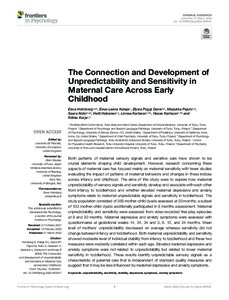Hae
Aineistot 1-10 / 14
Feasibility of FreeSurfer Processing for T1-Weighted Brain Images of 5-Year-Olds: Semiautomated Protocol of FinnBrain Neuroimaging Lab
<p>Pediatric neuroimaging is a quickly developing field that still faces important methodological challenges. Pediatric images usually have more motion artifact than adult images. The artifact can cause visible errors in ...
Subcortical and hippocampal brain segmentation in 5-year-old children: Validation of FSL-FIRST and FreeSurfer against manual segmentation
<p>Developing accurate subcortical volumetric quantification tools is crucial for neurodevelopmental studies, as they could reduce the need for challenging and time-consuming manual segmentation. In this study, the accuracy ...
Infant and Child MRI: A Review of Scanning Procedures
Magnetic resonance imaging (MRI) is a safe method to examine human brain. However, a typical MR scan is very sensitive to motion, and it requires the subject to lie still during the acquisition, which is a major challenge ...
The behavioral immune system and vaccination intentions during the coronavirus pandemic
<p>The behavioral immune system is considered to be a psychological adaptation that decreases the risk of infection. Research suggests that, in the current environment, this system can produce attitudes with negative health ...
Oxytocin receptor genotype moderates the association between maternal prenatal stress and infant early self-regulation
<p>Introduction</p><p>Maternal prenatal stress may have long-term adverse consequences for child development. Accumulating evidence shows that the oxytocin-receptor genotype may play a role in differential susceptibility ...
Children's diurnal cortisol output and temperament in two different childcare settings at 2 and 3.5 years of age
<p>Prior research suggests that child temperament may play an important role in early childhood stress regulation. We compared children's diurnal cortisol and the association between cortisol and temperament in two different childcare settings. Cortisol was measured from saliva samples over 2 days in children (N = 84) attending out-of-home childcare and in children (N = 27), who were cared for at home at the age of 3.5 years. There was no difference between the childcare groups in total diurnal cortisol. However, of the individual measurements, afternoon cortisol levels were higher in the out-of-home childcare group during their childcare day when compared with their home day. Child temperament was not associated with total diurnal cortisol. Comparison with our prior measurements showed that the association between temperamental surgency/extroversion and total diurnal cortisol diminished along with the child age from 2 to 3.5 years in both childcare settings. This may indicate that more extroverted children are physiologically more reactive to environmental stimuli when they are younger, but this association does not appear as the children develop. Our results further suggest that the afternoon hours in the out-of-home childcare may be demanding and accelerate the hypothalamus–pituitary–adrenal axis activation in young children independent of their age.<br></p>...
The role of alexithymia and perceived stress in mental health responses to COVID-19: A conditional process model
<p><strong>Background</strong><br>Little is known about the psychological mechanisms underlying the mental health problems related to the COVID-19 pandemic. Hypothetically, perceived stress and alexithymia may be factors ...
Associations between observed and reported infant negative affectivity, fear and self-regulation, and early communicative development-Evidence from the FinnBrain Birth Cohort Study
Self-regulation and language are intertwined abilities, but the nature of their relations in early childhood when both skills are still emerging is insufficiently understood. Our knowledge of the relations between early ...
The Connection and Development of Unpredictability and Sensitivity in Maternal Care Across Early Childhood
<p>Both patterns of maternal sensory signals and sensitive care have shown to be crucial elements shaping child development. However, research concerning these aspects of maternal care has focused mainly on maternal ...
Vanhempien masennus- ja ahdistusoireet lisääntyivät COVID-19-pandemian alkuvaiheessa - FinnBrain-syntymäkohorttitutkimus
<p>JOHDANTO : Aikuisten psyykkisen oireilun on havaittu lisääntyneen COVID-19-pandemian aikana. Harvassa tutkimuksessa on selvitetty pienten ja kouluikäisten lasten vanhempien oireiden muutosta toistomittausasetelmassa.< ...









